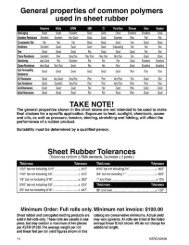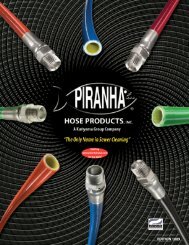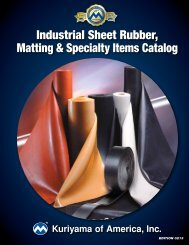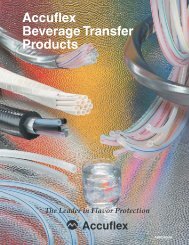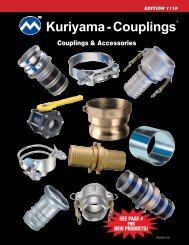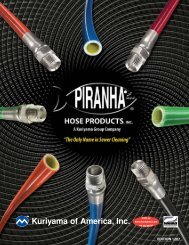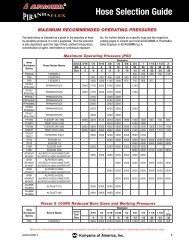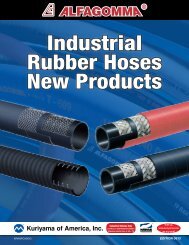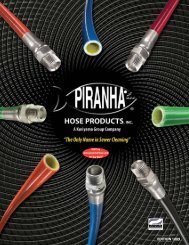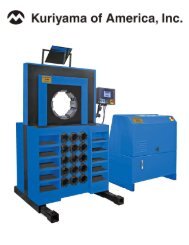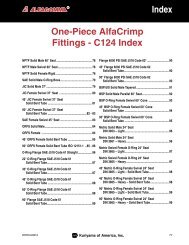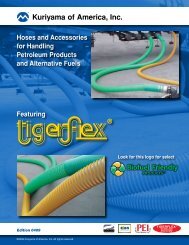®FITTING SUGGESTIONSFitting Suggestions for <strong>Kuri</strong> <strong>Tec</strong> ® Hose & TubingIt is extremely important that the fitting <strong>and</strong> <strong>hose</strong> or <strong>tubing</strong>be properly matched in size <strong>and</strong> type. The insert shouldalways be slightly larger than the <strong>tubing</strong> to create a slightexpansion <strong>of</strong> the tube <strong>and</strong> provide a good consistent seal.If a clamp or ferrule is used to compress the <strong>hose</strong>, cautionmust be used to prevent over-crimping the ferrule orover-tightening the clamp. More pressure does notnecessarily improve fitting retention.We do not recommend the use <strong>of</strong> reusable fittings unlessthe <strong>hose</strong> <strong>and</strong> fitting have been specifically designed tobe compatible <strong>and</strong> have been thoroughly tested incombination prior to use.Clamps over barbed fittingsdiameter for hydraulic fittings. For this reason, as ageneral rule we do not recommend the use <strong>of</strong> one-piececrimped hydraulic fittings with <strong>Kuri</strong> <strong>Tec</strong> <strong>hose</strong>s.Fig. 2AFig. 2BIn figures 2A <strong>and</strong> 2B above, two styles <strong>of</strong> crimping diehave been used successfully. The ferrules <strong>and</strong> fittings areproperly matched in length.Fig. 1AFig. 1CIn the illustrations above, the clamps are properlypositioned in Figure 1A <strong>and</strong> 1B, directly over the middlebarbs <strong>and</strong> behind the first barb. This is extremelyimportant in the case <strong>of</strong> single-barb fittings, as shown inFigure 1B, since the barb is generally much larger thanthe shank <strong>of</strong> the fitting. The compressed material cannotpass over the barb when under tension, thus securelyholding the fitting to the <strong>hose</strong>.In Figures 1C <strong>and</strong> 1D, the clamp has been improperlypositioned too close to the end <strong>of</strong> the fitting. In Figure1C, only the barb nearest the end <strong>of</strong> the fitting is effectivein maintaining fitting retention. The first two barbs serveno purpose whatsoever in providing fitting retention orleak resistance. In Fig. 1D, the situation is even worse,since the clamp can very easily cut the core tube over theenlarged barb, leading to leakage <strong>and</strong> subsequent coverblisters or bursts.When choosing multi-barb fittings for use with <strong>Kuri</strong> <strong>Tec</strong><strong>hose</strong>, as in Fig. 1A <strong>and</strong> 1C, it is important that the barbsnot be too deep. The core tubes in <strong>Kuri</strong> <strong>Tec</strong> <strong>hose</strong>s aregenerally somewhat harder than conventional rubbertubes <strong>and</strong> therefore the material cannot flow into the deepbarb, as it would with a s<strong>of</strong>t rubber compound.AcceptableFig. 1BFig. 1DUnacceptableFerrules crimped over barbed fittingsIn Fig. 2C, the ferrule is much shorter than the barbedinsert. Without the protection <strong>of</strong> the ferrule, repeatedharsh flexing <strong>of</strong> the <strong>hose</strong> at the fitting can damage thetube. In addition, the short ferrule does not take fulladvantage <strong>of</strong> the sealing or retention properties <strong>of</strong> thebarbed insert.In figure 2D, there are two potential problems: 1) Theexcessively-long ferrule can reduce the inside diameter<strong>of</strong> the <strong>hose</strong> just beyond the fitting; <strong>and</strong> 2) a single-barbfitting is not the ideal insert for a crimped ferrule. Because<strong>of</strong> the increased depth <strong>of</strong> the single barb, the tube can becut by the force <strong>of</strong> the crimping before sufficient compressionis exerted on the shank <strong>of</strong> the fitting.Compression FittingsCompression fittings depend solely on contact with theouter surface <strong>of</strong> the <strong>tubing</strong> to provide sealing <strong>and</strong> holdingpower. There is no seal on the inner surface <strong>of</strong> the <strong>tubing</strong>.With the exception <strong>of</strong> 220/221 Series LLDPE <strong>tubing</strong>, wedo not recommend the use <strong>of</strong> compression fittings with<strong>Kuri</strong> <strong>Tec</strong> <strong>hose</strong> <strong>and</strong> <strong>tubing</strong>. To work properly, the materialmust be hard <strong>and</strong> smooth <strong>and</strong> there must be no yarnreinforcement layer.Fitting suggestions for <strong>Kuri</strong> <strong>Tec</strong> ® spray <strong>hose</strong>sIn addition to the properly installed fittings shown in Fig.1A, 1B, 2A <strong>and</strong> 2B above, we also suggest the use <strong>of</strong> atwo-barb clamped fitting when high pressures are involved.When properly crimped, a metal ferrule over a multibarbedfitting can provide excellent fitting retention <strong>and</strong>leak resistance. However, excessive crimping pressurecan damage the core tube, leading to <strong>hose</strong> failure.ExtremePlease refercaretomustthealsobackbepagetakenfortothecontrollocationthe crimping<strong>of</strong> your nearest The warehouse double-barb for fitting, availability held in <strong>of</strong> place products/sizes by two properly shown.positioned clamps, provides excellent fitting retention <strong>and</strong>Because we continually examine ways to improve our products, we reserve the right to alter specifications OR DISCONTINUE PRODUCTS without prior notice.64 KKTCA0408Fig. 2CCompression SleeveFig. 2DPush-to-connect
®leak resistance without risk <strong>of</strong> damage to the core tubeor deterioration <strong>of</strong> the yarn reinforcement due to wicking.Hose failure near a fittingA <strong>hose</strong> is most susceptible to failure near the fitting. Theinstallation <strong>of</strong> the fitting involves some risk <strong>of</strong> damage tothe core tube. There is also some possibility <strong>of</strong> slightleakage along a fitting <strong>and</strong> subsequent yarn wicking,particularly if a one-piece crimped fitting is used. Thegreatest amount <strong>of</strong> flexing <strong>of</strong>ten occurs near the fitting ateither the supply or service end <strong>of</strong> the <strong>hose</strong>.In the investigation <strong>of</strong> a <strong>hose</strong> failure near the fitting, itis essential that the fitting/<strong>hose</strong> interface be examined.In the field, if the failure or deterioration is isolated tothe area near the fitting, it is best to cut <strong>of</strong>f the end <strong>of</strong>the <strong>hose</strong>, reinstall a new fitting, <strong>and</strong> monitor the <strong>hose</strong> inservice to see if the problem reoccurs.If the problem involves a spray <strong>hose</strong> <strong>and</strong> fluid slowlyleaking through the cover perforations near the fitting,the most likely cause is wicking along the reinforcingyarn from the end <strong>of</strong> the <strong>hose</strong> or from a cut or break inthe core tube. Such wicking can extend over several feet<strong>and</strong> a leak may be seen at a considerable distance fromthe source <strong>of</strong> the leak.If a <strong>hose</strong> is being returned to the supplier for investigation<strong>of</strong> a failure, it is essential that the fitting . . . or atleast the section <strong>of</strong> <strong>hose</strong> in contact with the fitting . . . bereturned. Only by examining the inner surface <strong>of</strong> the tubethat was in contact with the fitting can one determinewith certainty if the problem began at the fitting.WARNINGThe above comments <strong>and</strong> fitting suggestions are intendedfor use as guidelines only. The information provided isbased on tests which we believe to be reliable <strong>and</strong> onour past observations <strong>and</strong> experience. No warranty isexpressed or implied, as applications <strong>and</strong> methods <strong>of</strong>fitting installation can vary widely. Before placing a <strong>hose</strong>in service, the user must determine the suitability <strong>of</strong> thefitting <strong>and</strong> <strong>hose</strong>/tube for his or her intended use. Theuser assumes all risk <strong>and</strong> liability resulting from the use<strong>of</strong> any <strong>Kuri</strong> <strong>Tec</strong> product with any fitting whatsoever.FITTING SUGGESTIONSTemperature Dependence <strong>of</strong> Pressure RatingAs a general rule, the working pressure ratings forplastic reinforced <strong>hose</strong>s are based on room temperatureconditions. The maximum allowable pressure for a <strong>hose</strong>decreases as the temperature increases <strong>and</strong> the materialbecomes s<strong>of</strong>ter <strong>and</strong> more elastic. Fitting retentiondecreases at higher temperatures as the compression onthe material declines.Working pressure ratings can be affected significantly bythe type <strong>of</strong> fitting used, the method <strong>of</strong> attachment, <strong>and</strong>the temperature to which the <strong>hose</strong> assembly is exposedin service. Repeated intermittent periods <strong>of</strong> exposureto elevated temperatures can affect fitting retention<strong>and</strong> it is, therefore, very difficult to assign workingpressure ratings at high temperatures. The graph belowdemonstrates the overall trend.Burst strengthdecreases astemperatureincreasesWorking Pressure RatingsWorking pressure ratings are given in this catalog at 70°F No warranty is expressed or implied, as applications<strong>and</strong> 122°F. Between 122°F <strong>and</strong> the maximum service <strong>and</strong> methods <strong>of</strong> fitting installation may vary widely.temperature, it must be noted that a rapid decline in the Before placing a <strong>hose</strong> in service, the user mustpressure rating <strong>of</strong> the <strong>hose</strong> may occur, <strong>and</strong> all factors determine the suitability <strong>of</strong> the product under the correctrelating to the <strong>hose</strong>, fittings <strong>and</strong> service conditions must working conditions, <strong>and</strong> assumes all risk <strong>and</strong> liability inbe taken into consideration.connection therewith.Please refer to the back page for the location <strong>of</strong> your nearest warehouse for availability <strong>of</strong> products/sizes shown.Because we continually examine ways to improve our products, we reserve the right to alter specifications OR DISCONTINUE PRODUCTS without prior notice.KKTCA040865
- Page 1 and 2:
TMLeaders in ThermoplasticHose Inno
- Page 3 and 4:
®Kuri Tec ® Hose & Tubing Index b
- Page 5 and 6:
®TYPE DESCRIPTION PAGEReinforced A
- Page 7 and 8:
K1131 ®K1134 K1154K1136 K1156 K117
- Page 9 and 10:
®KLEARON 73Series K010Clear PVC T
- Page 11 and 12:
®Series 3300Ether-BasedPolyurethan
- Page 13 and 14: ®Series 2840, 2841,2844, 284695 Sh
- Page 15 and 16: ®221 SeriesLinear Low DensityIndus
- Page 17 and 18: ®Series A3236High PurityNon-Toxic
- Page 19 and 20: ®Series K6136High Purity Street to
- Page 21 and 22: ®Series 136Non-Toxic RV WaterHose
- Page 23 and 24: ®CLEARBRAID ®K3130 Series BFHeavy
- Page 25 and 26: ®Polywire ® PlusSeries K7300 Hose
- Page 27 and 28: ®POLYWIRE ®Series K7130Heavy Wall
- Page 29 and 30: Series A1141, A1144,A1146, A1148Spe
- Page 31 and 32: POLYAIR ®Series K1131, K1134,K1136
- Page 33 and 34: ®Series K1171, K1173K1174, K1176Ge
- Page 35 and 36: Series K2163Contractor PVCWater Hos
- Page 37 and 38: ®Series A1317Heavy Duty Reinforced
- Page 39 and 40: ®PNEU-THANE Series HS5090,HS5094,
- Page 41 and 42: ®Series HS1171,HS1174, HS1176Gener
- Page 43 and 44: ®Kuri Tec IPOP DisplayHose assembl
- Page 45 and 46: ®Series A4143S(with Static Wire)Me
- Page 47 and 48: ®Series A1687800 PSI PVC/Polyureth
- Page 49 and 50: ®Series K4131,K4132, K4137600 PSI
- Page 51 and 52: ®Series K4350EVA Yarn-ReinforcedSp
- Page 53 and 54: ®Considerations for Selecting and
- Page 55 and 56: ®Series A1263Low TemperatureNon-To
- Page 57 and 58: ®Series A4176Conductive PVCAir Hos
- Page 59 and 60: ®Series K7000Anti-Stat Blasting Tu
- Page 61 and 62: ®Custom Compounds/Extrusions• Co
- Page 63: ®Kuri Tec® hose and tubing produc
- Page 67 and 68: ®Key: E=Excellent G=Good L=Limited
- Page 69 and 70: ®Key: E=Excellent G=Good L=Limited
- Page 71 and 72: ®Key: E=Excellent G=Good L=Limited



